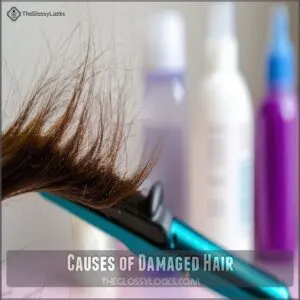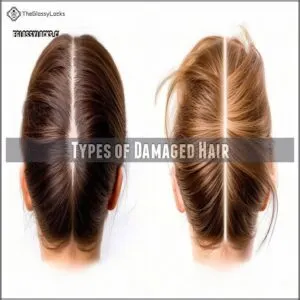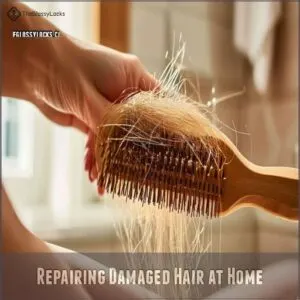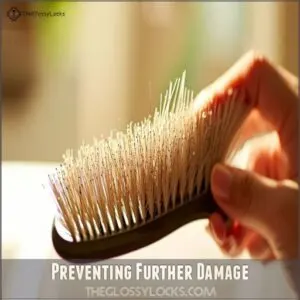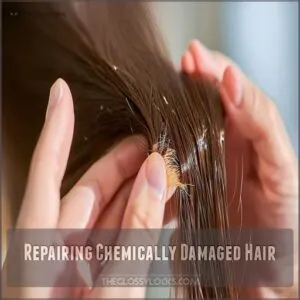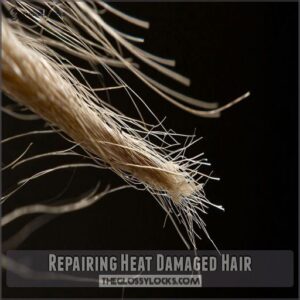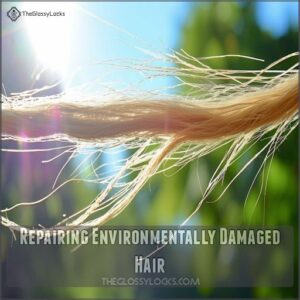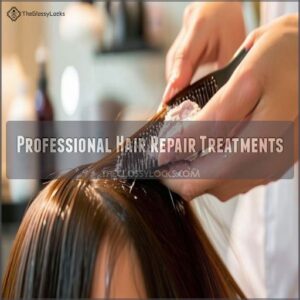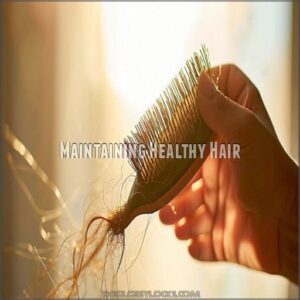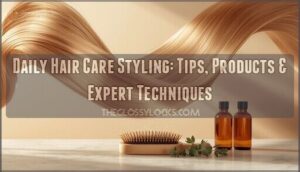This site is supported by our readers. We may earn a commission, at no cost to you, if you purchase through links.
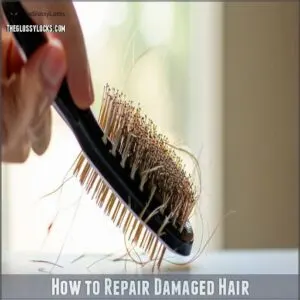
The good news? You can take control.
Start with a good quality shampoo and conditioner designed for damaged hair.
Regular trims are essential to get rid of split ends.
Deep conditioning treatments and hair masks will work wonders.
Try to limit heat styling and always use a heat protectant.
Remember, patience is key; healthy hair takes time.
We’ll explore even more effective techniques in the article—discover the secrets to truly luscious locks!
Table Of Contents
- Key Takeaways
- Causes of Damaged Hair
- How to Repair Damaged Hair
- Types of Damaged Hair
- Repairing Damaged Hair at Home
- Preventing Further Damage
- Repairing Chemically Damaged Hair
- Repairing Heat Damaged Hair
- Repairing Environmentally Damaged Hair
- Professional Hair Repair Treatments
- Maintaining Healthy Hair
- Frequently Asked Questions (FAQs)
- Can you repair damaged hair?
- How do you fix hair loss tendencies?
- What should I do if my hair is damaged?
- Is there a cure for damaged hair?
- Can home remedies help with damaged hair?
- How to repair damaged hair follicles?
- Can you grow damaged hair?
- How can I repair dry, damaged hair?
- Can coconut oil help repair damaged hair?
- Can damaged hair really be repaired?
- How can I repair my damaged hair at home?
- How do I get my hair healthy again?
- How long does it take to repair damaged hair?
- How long does it take to see hair improvement?
- Can diet affect hair repair effectiveness?
- Are natural oils effective in repairing hair?
- What are signs that hair is beyond repair?
- How does sleep impact hair health?
- Conclusion
Key Takeaways
- Use a moisturizing hair mask weekly to boost hydration.
- Limit heat styling and always use a heat protectant to minimize damage.
- Get regular trims to remove split ends and prevent further breakage.
- Choose gentle, sulfate-free shampoos and conditioners to maintain your hair’s natural oils.
Causes of Damaged Hair
You’re not alone if you’re wondering why your hair seems dry or brittle lately; it could be due to frequent hair dyeing, using hot styling tools, or even soaking up too much sun and chlorine.
Understanding these causes can help you take steps to protect your hair and keep it healthy.
Chemical Damage From Hair Dye
Ever wondered why your hair feels like straw after dyeing it? It’s a common problem! Harsh chemicals, like ammonia, can cause dye-related breakage.
Here’s what you can do:
- Choose ammonia-free dyes, but be aware of ammonia-free risks – they sometimes need longer processing times.
- Opt for moisture-rich formulas to keep your hair happy and hydrated.
- Consider semi-permanent dyes for less damage.
- When lightening dark brown hair, consider using semi-permanent dyes in ash or neutral tones for subtle lightening, before tackling home dye tips, remember to always do a strand test first! Protecting your hair is key to keeping it looking its best.
Physical Damage From Brushing and Heat Styling
Switching from harsh chemicals, let’s chat about taming tangles.
Brushing and heat styling often lead to hair stress, like your hairline giving off breakage signals.
Opt for soft-bristle brushes to prevent snap disasters.
Manage wet hair with a gentle wide-tooth comb—patience is key.
For heat tool survivors, keep temps low and apply a trusty heat protectant.
Environmental Damage From Sun and Chlorine
Too much sun or a dip in a chlorinated pool can turn your hair into a frizzy mess.
Here’s how to combat it:
- Sun protection: Wear a hat or use hair sunscreen.
- Chlorine damage: Wet hair with fresh water before swimming.
- Hair care tips: Rinse and use a swim shampoo.
- Hair mask: Add moisture post-swim.
How to Repair Damaged Hair
Give your hair the care it craves with moisture-rich masks and ditch the damaging heat styling for a healthier shine.
By incorporating these simple steps, you can transform dull and brittle strands into lustrous hair that’ll turn heads.
Use a Moisture-Rich Hair Mask
You’ve battled damaged hair, so it’s time for a treat.
Whip up a moisture-rich hair mask at home—it’s as soothing as a cozy blanket!
Think avocado, honey, or yogurt for nourishing ingredients.
Use it weekly to keep your hair luscious and hydrated.
A hair mask benefits your locks like a spa day for your strands.
Avoid Heat Styling and Use a Heat Protectant
Embracing moisture-rich hair masks can make your locks happier, but taming damage takes more.
Heat styling risks leave hair fried and frazzled.
Try these steps:
- Limit the heat—use it sparingly.
- Opt for heat protectants—sprays or serums offer choice.
- Lower temperatures—your hair will thank you.
- Experiment with air-drying—surprise yourself with natural texture!
Types of Damaged Hair
Understanding the types of damaged hair can help you tailor your hair care routine to address specific issues like brittleness or thinning.
Whether it’s tackling coarse texture from overprocessing or managing tangles from brushing, knowing what you’re dealing with is the first step to healthier locks.
Brittle Hair From Lack of Moisture
Dealing with brittle hair? Lack of moisture is often the culprit.
Think of your hair like a thirsty plant – it needs hydration! Dry hair becomes brittle, easily breaking.
Simple moisture tips can help. Try a hair mask, packed with nourishing ingredients. Home remedies, like using a leave-in conditioner, can work wonders. Regular hair masks are key for hair hydration.
Remember, healthy, moisturized hair is strong hair!
Thinning Hair From Hormonal Imbalance
Hormonal imbalances, such as those caused by menopause and PCOS, can disrupt the normal hair growth cycle and lead to excessive shedding. If brittle hair’s moisture is your puzzle, consider thinning hair‘s hormonal twists. Hormonal changes and stress can sneak up on your hair, resulting in thinning strands.
- Explore how menopause impacts hair, as it often changes texture and volume.
- Focus on a diet rich in nutrients like L-lysine and selenium.
- Consider hair loss treatments to regain fullness.
Coarse Hair From Overprocessing
Overprocessing can leave your hair feeling coarser than sandpaper.
To soften hair texture, try ditching harsh dyes and chemicals.
For an intense dose of moisture, consider shopping for coconut oil hair mask products online coconut oil hair mask products. Embrace moisture-rich conditioners, and go for DIY treatments like coconut oil masks.
For product recommendations, look for ones specifically designed to repair damage.
If DIY isn’t cutting it, professional solutions like salon protein treatments can bring back smoothness and shine.
Tangled Hair From Poor Brushing Techniques
Tangles got you tied up in knots? Poor brushing can lead to all sorts of hair havoc. Instead of tearing through knots, try these detangling tips:
- Gently use a wide-tooth comb on dry strands.
- Avoid brushing wet hair to reduce breakage.
- Select brush types with soft, flexible bristles to protect your hair texture from brush damage.
Repairing Damaged Hair at Home
You can easily take charge of your hair’s recovery at home with simple yet effective strategies.
Embrace leave-in conditioners and hair oils, mix up a DIY hair mask using natural ingredients, detangle with a wide-tooth comb, and remember to steer clear of brushing wet hair.
Use a Leave-in Conditioner and Hair Oil
For healthier hair, a leave-in conditioner and the right hair oil are your best friends.
They work like superheroes, swooping in to provide moisture and shine.
Include them in your damaged hair routine for smoother, manageable strands.
Whether it’s argan or coconut, choose oils wisely to nourish and protect.
A simple application can make all the difference.
Try a DIY Hair Mask With Natural Ingredients
Whipping up a DIY hair mask is like giving your hair a buffet of goodness.
Mix natural ingredients for a nourishing treat that’s easy to whip up at home.
Try these:
- Avocado and honey: Perfect for moisture.
- Yogurt and egg: Great for strengthening.
- Coconut oil and aloe vera: A soothing, hydrating combo.
Apply weekly for lush, silky locks.
Use a Wide-Tooth Comb for Detangling
Homemade hair masks are great, but let’s talk detangling.
A wide-tooth comb is your new best friend.
Start at the ends, gently working your way up.
This prevents breakage, especially for those with fine or curly hair.
The right comb and technique make all the difference!
Experiment to find the best comb for your hair type.
Gentle detangling keeps your hair looking healthy and happy.
Avoid Brushing Wet Hair
Wet hair breakage is no joke.
Brushing wet hair can cause damage and lead to breakage, which is why you should use gentle scalp massage techniques.
Instead of brushing, gently detangle with a comb.
Think of it like handling a fragile piece of art.
Use those detangling tips wisely: start from the tips and work up.
Towel drying also helps reduce tension on your hair, maintaining its elasticity.
Preventing Further Damage
To keep your hair from getting worse, switch to a nourishing shampoo and conditioner that strengthen and protect.
Regular trims to tackle split ends and using sunscreen for your hair will keep it shining, not whining, in the sun.
Use a Better Shampoo and Conditioner
Choosing the right shampoo and conditioner can make a world of difference for your hair.
Opt for sulfate-free shampoos—they’re gentler and preserve your natural oils.
Look for nourishing ingredients like argan oil and keratin.
Match products to your hair type for the best results.
Brands like SheaMoisture and Pantene offer excellent options, leaving your strands smooth and manageable.
Get Regular Trims to Prevent Split Ends
Regular trims keep split ends at bay, just like pruning roses.
You’ve nailed finding the best shampoo; now focus on trimming frequency.
Understanding that factors like heat styling and chemical treatments can cause split ends, a good rule of thumb is to trim every 6-8 weeks, letting you cut ties with damaged tips.
Learn how to trim split ends at home.
DIY trim tips can work, but a salon visit guarantees precision.
Feel the freedom, knowing your hair’s in control and healthier with each snip.
Use a Hair Sunscreen for UV Protection
While trimming can keep those pesky split ends at bay, don’t forget that the sun can wreak havoc on your hair too.
Arm your strands with a sunscreen. Here’s how:
- Spray on a UV protectant to shield against UV damage.
- Wear a hat for ultimate sun protection.
- Use leave-in treatments for healthier, damage-free hair.
Limit Chlorine Exposure
Jump in with confidence and protect your hair from chlorine damage.
Before the pool, coat your strands with a leave-in conditioner or oil to create a barrier.
Rinse your hair with fresh water first—kind of like teaching it to swim.
After splashing around, wash with a swim-specific shampoo.
These swimming tips help keep your hair healthy.
Repairing Chemically Damaged Hair
So, you’ve got chemically damaged hair? Don’t worry, we’ll show you how to repair it and get your locks looking and feeling their best again!
Use a Moisture-Rich Hair Dye
Imagine your hair as a thirsty sponge—are you quenching it? When dyeing, choose a moisture-rich formula. It doesn’t just color; it cares.
- Protects against color damage with conditioning ingredients.
- Improves hair health by adding essential moisture.
- Reduces hair porosity, making strands smoother.
- Revives dull hair, turning it into a vibrant masterpiece.
Only Dye Your Roots to Minimize Damage
Instead of coloring your entire mane every time your roots grow, stick to root touch-ups for minimal damage.
This approach lowers the dyeing frequency, reducing stress on your locks and preventing color fading.
Let your tips breathe while you keep the vibrancy at your scalp.
It’s like letting your hair come up for air, promoting healthier and fuller growth.
Use a Bond-Repairing Hair Treatment
Every once in a while, your hair could use a little extra love with bond-repairing treatments, such as Olaplex Bonding Oil products, which can be used daily to restore healthy texture, minimize flyaways, repair damaged hair, and protect against heat damage. These treatments dive deep to mend broken bonds from chemical damage.
- Bond-repairing treatment types: Look for professional brands like Olaplex.
- DIY bond repair: Try DIY recipes with egg and avocado.
- Hair bonding science: Repairs internal structure.
- Bond repair vs. deep conditioning: Deeper than conditioning!
Repairing Heat Damaged Hair
When your hair feels like it’s been through a heatwave, reaching for a heat protectant spray or serum before styling can be a lifesaver.
Keep those hot tools on a lower setting to prevent further damage and give your tresses a break.
Use a Heat Protectant Spray or Serum
When dealing with heat-damaged hair, embracing a heat protectant spray or serum is your hair’s best friend.
Whether you prefer a spray for light coverage or a serum for richer protection, using it before styling can save your strands.
It’s like a superhero cape, shielding your hair from damage.
Test different products to find what works best!
Lower The Temperature on Hot Tools
Cranking down the temperature on your hair tools can make a world of difference. High heat leads to brittle, dry strands. So, give your hair a break:
- Dial down the heat by choosing medium settings.
- Minimize damage by limiting use to a few times a week.
- Spot test on a cooler setting first.
- Save your locks by finishing with air-dry moments.
Use a Thermal Protectant Spray
Lowering the heat is a great start, but let’s add another layer of protection.
Thermal protectant sprays create a shield between your hair and the heat.
Look for sprays with silicones or polymers—they’re your hair’s best friends! Spray it evenly before styling. Many great brands are available; find one that fits your budget.
A good protectant spray will help keep your hair healthy and happy.
Repairing Environmentally Damaged Hair
Sun exposure can leave your hair feeling like straw, but you don’t have to suffer in silence. Here’s a plan to tackle sun-damaged hair.
First, hydrate with a leave-in conditioner to lock in moisture.
Next, protect those luscious locks with a hair sunscreen that acts like a shield.
Additionally, using a sulfate-free shampoo can help prevent stripping away color and leaving hair feeling like straw, as explained in hair color damage repair tips.
Third, rinse your hair with fresh water before a dip to defend against chlorine damage.
Professional Hair Repair Treatments
Don’t let your hair struggle alone; professional treatments can be a game-changer.
To maintain healthy locks, consider using a best keratin shampoo conditioner to repair and nourish your hair, then consider visiting a salon for an in-depth hair repair solution that might include moisture-boosting masks or bond-repairing treatments to restore your hair’s health.
Consider an In-Salon Treatment for Damaged Hair
If your hair is plagued by dry and brittle texture, breakage, or dullness, it might be a sign that you need to repair your damaged hair, and learning what damaged hair looks like can be a good starting point. Considering a salon treatment for your damaged hair can be a game-changer.
It’s like giving your locks a mini-vacation—costs vary, but the results are often worth it.
From deep conditioning to keratin treatments, salons offer a buffet of options.
Expect smoother, shinier hair that feels rejuvenated.
For those tight on time or budget, there are at-home alternatives to explore.
Ask Your Stylist for a Bond-Repairing Treatment
Treat your locks to a bond-repairing treatment at your salon, which can also help repair damage caused by harsh adhesives, such as bonding glue removal.
Just like a lifebuoy for your strands, these treatments work wonders on stubborn damage.
Chat with your stylist about the best option for your hair type and watch those brittle ends transform.
It’s like a spa day for those hardworking tresses—pamper them, and they’ll thank you in shine and strength!
Get a Hair Mask Treatment for Moisture
Once you’ve chatted with your stylist about bond-repairing treatments, it’s time to pamper your tresses with a moisture-rich hair mask.
Think of it as giving your hair a spa day!
You can also explore various moisturizing hair mask options.
From creamy DIY masks using avocado and honey to store-bought wonders, the best hair masks can rejuvenate.
Use them weekly to maintain luster and bounce.
Maintaining Healthy Hair
Keeping your hair healthy is like nurturing a delicate plant—it needs the right care and attention.
Start with a balanced diet rich in nutrients like iron and biotin, as these are the building blocks for hair growth.
Using a hair repair mask can help repair and restore damaged locks.
Choose gentle hair products, steering clear of harsh chemicals that strip moisture.
Scalp health is essential, so give it a little TLC with regular massages to boost circulation.
If stress has you pulling your hair out, try management strategies like yoga or meditation to keep those strands intact.
And remember, just like you wouldn’t wear the same outfit every day, switch up your hair routine to keep it fresh.
Embrace these habits and watch your hair thrive with vitality and resilience.
Frequently Asked Questions (FAQs)
Can you repair damaged hair?
You can’t fully reverse hair damage, but you can improve its health and appearance.
Trim split ends, hydrate with conditioners, minimize heat styling, and shield from sun and chemicals to protect your locks.
How do you fix hair loss tendencies?
Combat hair loss by maintaining a balanced diet rich in iron and vitamins.
Reduce stress through relaxation techniques.
Keep your scalp healthy by regularly massaging it to boost circulation.
Consider consulting a healthcare professional for personalized advice.
What should I do if my hair is damaged?
Think your hair’s enjoying a wild rollercoaster?
Time to step off and pamper it!
Use a hydrating mask weekly, avoid heat styling, and trim regularly.
Embrace gentle products to rejuvenate that frazzled mane.
You’ve got this!
Is there a cure for damaged hair?
There’s no magical cure for damaged hair, but you can manage it.
Moisturizing treatments, gentle handling, and minimizing heat and chemical exposure are key.
Treat your hair kindly and watch it slowly regain its healthy appearance.
Can home remedies help with damaged hair?
Home remedies can help with damaged hair by using heat protectants like those that fix burnt hair from curling iron to prevent further damage, restoring moisture and shine.
To naturally lighten your hair, consider using a treatment that involves baking soda hair lightening, which can remove stains and semi-permanent hair color. Coconut oil masks for hydration, apple cider vinegar rinses to balance pH, or honey treatments for added softness.
These natural solutions offer gentle, effective care.
How to repair damaged hair follicles?
Remember Sarah’s heat-damaged hair?
You can’t fully repair follicles, but you can improve their health.
Focus on gentle cleansing, deep conditioning, and minimizing heat styling.
A healthier scalp promotes stronger hair growth.
Can you grow damaged hair?
Yes, you can grow damaged hair healthier by pampering it with good care.
Use nourishing shampoos and conditioners, avoid excessive heat, trim regularly, and maintain a balanced diet.
Patience and consistent care will gradually improve your hair’s condition.
How can I repair dry, damaged hair?
Treat your hair like a delicate flower: nurture it with hydrating masks, trim regularly to remove split ends, and avoid harsh treatments.
Use sulfate-free shampoos and conditioners, embrace air drying, and protect it from the sun.
Can coconut oil help repair damaged hair?
Coconut oil can be a lifesaver for damaged hair, offering deep hydration and reduced breakage.
It seeps into hair shafts, boosting moisture and shine.
Giving your locks a much-needed revival with a tropical twist.
Can damaged hair really be repaired?
Your hair’s like a road trip—it can’t be truly reversed but rerouted.
You can’t repair damage completely, but with proper care, like moisture treatments and reduced heat styling, you can manage and improve its appearance.
How can I repair my damaged hair at home?
Moisturize regularly with deep conditioners, limit heat styling, and opt for gentle shampoos.
Avoid harsh chemicals.
Instead, wrap your hair in a towel to dry and use protective hairstyles.
With consistent care, your hair’s condition will improve.
How do I get my hair healthy again?
Ironically, achieving healthy hair doesn’t come from more products but from dialing back.
Embrace gentle shampoos, regular trims, and a balanced diet.
Protect hair from heat and sun, and let its natural strength shine through.
How long does it take to repair damaged hair?
Minor damage mends quickly, maybe a few weeks with good care. Severe damage? Think months of TLC. Patience is key; healthy hair’s a marathon, not a sprint.
How long does it take to see hair improvement?
Funny how patience is your hair’s best friend, isn’t it?
Expect noticeable improvements in four to six weeks with consistent care.
Stick to nourishing routines and watch as your hair gradually regains its health and shine.
Can diet affect hair repair effectiveness?
Your diet plays a major role in hair repair.
Nutrient-rich foods help nourish your hair from the inside out.
So, munch on proteins, vitamins, and minerals to boost your hair’s recovery and improve overall health.
Are natural oils effective in repairing hair?
Natural oils like argan or coconut can deeply condition your hair, reducing damage and adding shine.
They penetrate the hair shaft to moisturize and repair.
Consider them nature’s little miracle workers for healthier hair.
What are signs that hair is beyond repair?
When your hair feels like straw, snaps easily, or has a rough texture that styling can’t fix, it could be beyond repair.
Seek professional help or consider a fresh cut to start anew.
How does sleep impact hair health?
Getting a good night’s sleep boosts hair health by allowing your body to repair and grow hair.
Lack of rest may lead to stress, impacting hormone levels and slowing hair growth.
So, sleep tight for vibrant hair!
Conclusion
Transforming damaged hair requires commitment, care, and consistency.
By understanding how to repair damaged hair, you can restore its health and vibrancy.
Embrace moisturizing masks, minimize heat styling, and choose gentle products designed for your hair’s needs.
Remember to trim regularly and shield your strands from sun and chlorinated water.
While patience is key, these 10 essential tips bring you closer to luscious locks.
So, take these steps today, for a future of healthy, beautiful hair.

